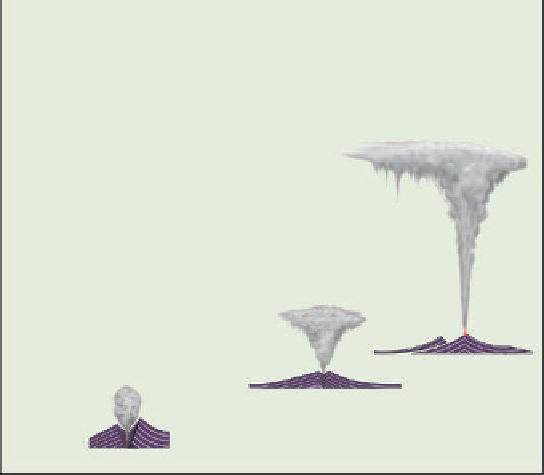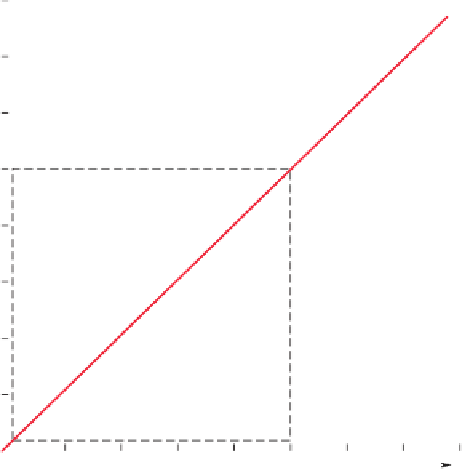Geology Reference
In-Depth Information
?
VEI numbers, but none has exceeded 7, and most (62%) were
assigned a value of 2.
The duration of eruptions varies considerably. Fully
42% of about 3300 historic eruptions lasted less than one
month. About 33% erupted for one to six months, but some
16 volcanoes have been active more or less continuously for
more than 20 years. Stromboli and Mount Etna in Italy and
Erta Ale in Ethiopia are good examples. For some explo-
sive volcanoes, the time from the onset of their eruptions
to the climactic event is weeks or months. A case in point
is the colossal explosive eruption of Mount St. Helens on
May 18, 1980, that occurred two months after eruptive activity
began. Unfortunately, many volcanoes give little or no warn-
ing of such large-scale events; of 252 explosive eruptions,
42% erupted most violently during their fi rst day of activity.
As one might imagine, predicting eruptions is complicated
by those volcanoes that give so little warning of impending
activity.
What Would You Do
No one doubts that some of the Cascade Range volcanoes
will erupt again, but we don't know when or how large these
eruptions will be. A job transfer takes you to a community in
Oregon that has several nearby large volcanoes. You have
some concerns about future eruptions. What kinds of in-
formation would you seek out before buying a home in this
area? In addition, as a concerned citizen, can you make any
suggestions about what should be done in the case of a large
eruption?
How Long Do Eruptions Last?
The most widely used indication of the size of a volcanic erup-
tion is the
volcanic explosivity index (VEI)
(
Figure 5.18).
Unlike the Richter Magnitude Scale for earthquakes (see
Chapter 8), the VEI is only semiquantitative, being based partly
on subjective criteria.
The VEI ranges from 0 (gentle) to 8 (cataclysmic) and is
based on several aspects of an eruption, such as the volume
of material explosively ejected and the height of the eruption
plume. However, the volume of lava, fatalities, and property
damage are not considered. For instance, the 1985 eruption of
Nevado del Ruiz in Colombia killed 23,000 people, yet has a
VEI value of only 3. In contrast, the huge eruption (VEI = 6)
of Novarupta in Alaska in 1912 caused no fatalities or inju-
ries. Since
A
.
D
. 1500, only the 1815 eruption of Tambora had
a value of 7; it was both large and deadly (Table 5.1). Nearly
5700 eruptions during the last 10,000 years have been assigned
◗
Only a few of Earth's potentially dangerous volcanoes are
monitored, including some in Japan, Italy, Russia, New
Zealand, and the United States. Volcano monitoring involves
recording and analyzing physical and chemical changes at
volcanoes (
Figure 5.19). Tiltmeters detect changes in the
slopes of a volcano as it infl ates when magma rises beneath
it, and a geodimeter uses a laser beam to measure horizon-
tal distances, which change as a volcano infl ates. Geologists
also monitor gas emissions, changes in groundwater level
and temperature, hot springs activity, and changes in the
local magnetic and electrical fi elds. Even the accumulating
snow and ice, if any, are evaluated to anticipate hazards from
fl oods should an eruption take place.
Of critical importance in volcano
monitoring and warning of an im-
minent eruption is the detection of
volcanic tremor
, continuous ground mo-
tion that lasts for minutes to hours as op-
posed to the sudden, sharp jolts produced
by most earthquakes. Volcanic tremor, also
known as
harmonic tremor
, indicates that
magma is moving beneath the surface.
To more fully anticipate the future
activity of a volcano, its eruptive history
must be known. Accordingly, geologists
study the record of past eruptions pre-
served in rocks. Detailed studies before
1980 indicated that Mount St. Helens,
Washington, had erupted explosively 14
or 15 times during the last 4500 years,
so geologists concluded that it was one
of the most likely Cascade Range volca-
noes to erupt again. In fact, maps they
prepared showing areas in which dam-
age from an eruption could be expected
were helpful in determining which areas
should have restricted access and evacu-
ations once an eruption did take place.
◗
1000 km
3
8
100 km
3
7
10 km
3
6
Very large
5
1km
3
Large
0.1 km
3
4
VEI 4-7
0.01 km
3
3
Moderate
VEI 3-5
1,000,000 m
3
2
Plinian
Small
VEI 1-3
Vulcanian
10,000 m
3
1
Strombolian
1000 m
3
0
<0.1
0.1-1
1-5
3-15
10-25
>25
Cloud height, km
Historic eruptions
487
623
3176
733
119
19
5
1
0
◗
Figure 5.18
The Volcanic Explosivity Index In this example, an eruption with a VEI of 5
has an eruption cloud up to 25 km high and ejects at least 1 km
3
of tephra, a collective term
for all pyroclastic materials. Geologists characterize eruptions as Hawaiian (nonexplosive),
Strombolian, Vulcanian, and Plinian.











Search WWH ::

Custom Search